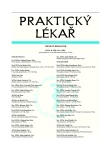Human biomonitoring – its importance and application for evaluating population exposure to environmental chemicals (toxins)
Authors:
M. Černá 1; A. Krsková 2
Authors‘ workplace:
Universita Karlova v Praze
3. lékařská fakulta
Děkan: prof. MUDr. Michal Anděl, CSc.
Ústav obecné hygieny
Přednosta: prof. MUDr. Milena Černá, DrSc.
1; Státní zdravotní ústav v Praze
Ředitelka: Ing. Jitka Sosnovcová
Centrum odborných činností
Vedoucí: doc. MUDr. Pavel Urban, CSc.
2
Published in:
Prakt. Lék. 2010; 90(8): 474-479
Category:
Of different specialties
Overview
Human biomonitoring is a tool that has been used more frequently in recent years to determine population exposure to environmental chemicals, to monitor time trends, to assess health risks and to confirm the efficacy of preventive measures. Biomonitoring is defined as a measurement of chemicals, their metabolites or other pathophysiological changes related to exposure (generally called biomarkers) in human body fluids and tissues of the general population. Reference values (95% percentile of measured values) indicate the upper margin of background exposure in a given population. Health-based limit values have been defined for certain biomarkers; when these levels are exceeded there are potential health risks for the population. In the Czech Republic, human biomonitoring has been carried out since 1994 within the framework of the Environmental Health Monitoring System. It includes the monitoring of selected heavy metals (Pb, Cd, Hg) in blood, urine and hair, and persistent chlorinated organic compounds (like DDT, PCBs) in lipids of human milk or blood serum. This article discusses the requirements for sampling body fluids and analysis of biomarkers, as well as interpretation of results. Human biomonitoring procedures in European countries will be harmonized through the COPHES project within the European Union 7th Framework Program.
Key words:
biomonitoring, population exposure, reference and limit values.
Sources
1. Aitio, A. Biological monitoring today and tomorrow. Scand. J. Work. Environ. Health, 1994, 20, p. 46-58.
2. Bardoděj, Z., David, A., Šedivec, V. a kol. Exposiční testy v průmyslové toxikologii. 1. vyd. Praha: Avicenum, 1980. 368 s.
3. Batáriová, A., Spěváčková, V., Beneš, B. et al. Blood and urine levels of Pb, Cd and Hg in the general population of the Czech Republic and proposed reference values. Int. Arch. Occup. Environ. Health, 2006, 209, p. 359-366.
4. Bencko, V. Use of human hair as a biomarker in the assessment of exposure to pollutants in occupational and environmental settings. Toxicology, 1995, 101, p. 29-39.
5. Binková, B., Lewtas, J., Míšková, I., et al. Biomarker studies in Northern Bohemia. Environ. Health. Perspect. 1996, 104 (suppl. 3), p. 591-597.
6. Centers for Disease Control (CDC). Fourth national report on human exposure to environmental chemicals 2009 [online]. Dostupné na http://www.cdc.gov/exposurereport/.
7. Černá, M. Biomonitoring - jeho význam a využití v hodnocení a řízení rizika. I. Základní informace. Hygiena 1997, 42, 1, s. 31-36.
8. Černá, M., Spěváčková, V. Biomonitoring - II. Odběr biologických vzorků. Hygiena 1998, 43, 4, s. 227-231.
9. Černá, M., Spěváčková, V., Batáriová, A. et al. Human biomonitoring system in the Czech Republic. Int. Arch. Occup. Environ. Health 2007, 210, p. 495-499.
11. Černá M., Spěváčková V., Beneš B. a kol. Biomonitoring III. Výsledky analýzy vybraných toxických stopových prvků (Pb, Cd, Hg) v krvi české populace. Čes. a Slov. Hygiena 2004, 1, s. 4-7.
12. Ewers, U., Krause, C., Schulz, C., Wilhelm, M. Reference values and human biological monitoring values for environmental toxins. Int. Arch. Occup. Environ. Health 1999, 72, p. 255-260.
13. Guidotti, T.L., McNamara, J., Mores, M.S. The interpretation of trace element analysis in body fluids. Indian J. Med. Res. 2008, 128, p. 524-532.
14. Kliment V., Kubínová R., Černá M., a kol. Systém monitorování zdravotního stavu obyvatelstva ČR ve vztahu k životnímu prostředí – souhrnné výsledky za období 1994-2003. Čes. a Slov. Hygiena 2005, 3, s. 85-94.
15. Poulsen, O.M., Holst, E., Christensen, J.M. Calculation and application of coverage intervals for biological reference values. IUPAC, Pure and Applied Chemistry 1997, 69, p. 1601-1611.
16. Rössner, P., Šrám, R.J., Bavorová, H. et al. Spontaneous level of chromosomal aberrations in peripheral blood lymphocytes of control individuals of the Czech Republic population. Toxicol. Lett. 1998, 96/97, p. 137-142.
17. Rössner, P., Černá, M., Bavorová, H. et al. Monitoring of human exposure to occupational genotoxicants. Centr. Eur. J. Publ. Health 1995, 3(4), p. 219-223.
18. Schulz, C., Angerer, J., Ewers, U. et al. Revised and new reference values for environmental pollutants in urine or blood of children in germany derived from the German Environmental Survey on children 2003-2006 (GerES IV). Int. J. Hyg. Environ.-Health 2009, 212, p. 637-647.
19. Schulz, C., Angerer, J., Ewers, U., Kolossa-Gehring, M. The German Human Biomonitoring Commission. Int. J. Hyg. Environ. Health 2007, 210, p. 373-382.
20. Šrám, R.J., Binková, B. Molecular epidemiology studies on occupational and environmental exposure to mutagens and carcinogens (1997-1999). Environ. Health Perspect. 2000, 108, p. 283-287.
21. Tuček, M., Cikrt, M., Pelcová, D. Pracovní lékařství pro praxi. Praha: Grada, 2005, 327 s. ISBN 80-247-0927-9.
22. WHO/IPCS. Biomarkers and Risk Assessment: Concepts and Principles, Environmental Health Criteria 155. Geneva: WHO, 1993, 82 p.
23. WHO/IPCS. Principles for the assessment of risks to human health from exposure to chemicals. Environmental Health Criteria 210. Geneva: WHO, 1999, 110 p.
24. Wilhelm, M., Ewers, U., Schulz, Ch. Revised and new reference values for some trace elements in blood and urine for human biomonitoring in environmental medicine. Int. J. Hyg. Environ. Health, 2004, 207, p. 69-73.
25. Zákon o ochraně veřejného zdraví č. 258/2000 Sbírky.
Labels
General practitioner for children and adolescents General practitioner for adultsArticle was published in
General Practitioner

2010 Issue 8
Most read in this issue
- Spontaneous intracranial hypotension
- Zinc and its relation to prostate tumours
- Human biomonitoring – its importance and application for evaluating population exposure to environmental chemicals (toxins)
- Physical activity as a part of cardiovascular disease prevention in the general practitioner’s surgery
